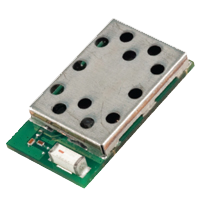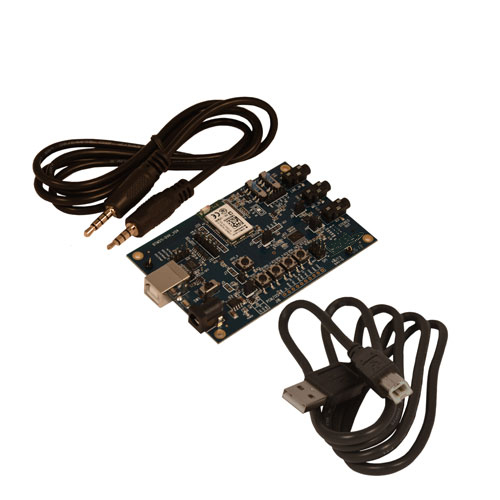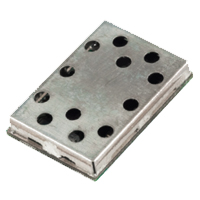BTM511 Series Audio Bluetooth Module

Overview
The BTM511 is a low-power Bluetooth module from Ezurio designed for integrating robust audio and voice capabilities to OEM devices. Based on the market-leading Cambridge Silicon Radio BC05 chipset, these modules provide exceptionally low power consumption with outstanding range. Supporting Bluetooth Version 3.0 specification, these modules provide the important advantage of Simple Secure Pairing (SSP) that improves security and enhances easy use. BTM511 modules come standard with SBC, AAC and apt-X audio codec support for high quality stereo audio applications.
BTM511 modules are provided with CSR’s apt-X codec without additional license fees. CSR’s world renowned apt-X™ audio compression solutions retain the full integrity of original digital audio and are optimized for instant real-time audio streaming.
To speed product development and integration, Laird has developed a comprehensive AT command interface that simplifies application development, including support for audio and headset functionality. Combined with a low-cost development kit, Laird’s Bluetooth modules provide faster time to market.
Note: The BTM510-xx variant has reached end of production and is available on a limited basis only. Only the BTM510 part numbers are affected. Find the End of Life Announcement in the Documentation tab below.
Buy Now
Specifications
UART: Greater than 300 Kbps
I2S / PCM: Master / slave roles
Microphone: Stereo microphone input
Idle (sleep) < 1.0 mA
Configurable Sniff mode and Sniff sub rating
I/O: 1.7 V to +3.6 V DC
| Part Number | Price @ 1K | Antenna Type | Bluetooth Version | Chipset (Wireless) | Connector | Data Rate | Frequency Range (Max) | Frequency Range (Min) | Logical Interfaces | OS/Software | Product Type | Protocols | Range | Receive Sensitivity | Software | System Architecture | Technology | Transmit Power (Max) | Weight | Wi-Fi Coexistence | Wireless Specification |
|---|---|---|---|---|---|---|---|---|---|---|---|---|---|---|---|---|---|---|---|---|---|
BTM511 EOL Buy Options | N/A | Internal | v3.0 | QCA (CSR) BC05 | SMT | 3 MBps | 2480 MHz | 2402 MHz | I2S, PCM, GPIO, Serial | Embedded Stack | Embedded Module | AT Command Set Multi-Point API | Up to 30 meters | -86 dBm | Terminal Software | Hosted | Bluetooth Classic, Bluetooth 3.0 | +4 dBm | .105 oz (3 g) | 2 wire and 3 wire schemes supported | Bluetooth v3.0 |
Documentation
Browse Application Notes, Certifications, Datasheets, Documentation, Product Briefs and Software in our Support & Documentation Center.
Is it safe to run a Ezurio Bluetooth module through a PCBA wash cycle?
In general, cleaning the populated modules is strongly discouraged. Residuals under the module cannot be easily removed with any cleaning process.
- Cleaning with water can lead to capillary effects where water is absorbed into the gap between the host board and the module. The combination of soldering flux residuals and encapsulated water could lead to short circuits between neighboring pads. Water could also damage any stickers or labels.
- Cleaning with alcohol or a similar organic solvent will likely flood soldering flux residuals into the RF shield, which is not accessible for post-washing inspection. The solvent could also damage any stickers or labels.
- Ultrasonic cleaning could damage the module permanently.
However, if water washing is required you will need to use deionized water. We do not recommend chemical cleaning and cannot guarantee it will not damage the modules. If you MUST clean PCB with chemicals it is recommended that you test on one board and then confirm the module still works after the process, prior to adding it to production, while understanding the above affects washing the populated PCBs can have on the module.
What is the throughput of your bluetooth modules with the embedded AT command interface?
Our fully-embedded modules have a throughput of around 300-360 kbps. They have an on-board Bluetooth stack and do all of the Bluetooth processing themselves. Bluetooth 2.1 + EDR has a practical transfer rate of 2.1 Mbit/s, but this is not possible on a small embedded module that does not have a powerful PC-type processor.
Can the BTM511 act as both an A2DP source and A2DP sink?
Yes, the BTM511 can act as either an A2DP source or an A2DP sink but not both at the same time.
For more information, see our list of Bluetooth Profiles.
Does the BTM511 come with an AAC license?
The BTM511 firmware contains AAC technology which incorporates intellectual property owned by numerous third parties. Supply of this product does not convey a license under the relevant intellectual property of those third parties nor imply any right to use this product in any finished end user or ready-to-use final product. An independent license for such use is required. A license is not required for development purposes. For details, please visit http://www.vialicensing.com.
Does the BTM511 come with aptX license?
The BTM511 comes with a full aptX licence included in the price of the module.
For more information, see the BTM51X page.
What Bluetooth profiles are supported on the BTM511?
Currently the BTM511 supports , A2DP, SPP, HFP, HF and AVRCP 1.0.
Can I write my own code for the DSP within the BTM511?
No, not generally. The DSP in the BTM511 is used for certain audio processing algorithms supplied by CSR such as Clear Voice Capture (CVC) and Music Manager. If you have a specific DSP requirement please contact support.
Is Sniff Mode supported only as a Slave or as a master or Slave in the BTM41x and BTM51x modules?
Based on a scenario between two BTM41x modules (referenced in the BTM41x Low Power Modes Application Note), the role of a device (master/slave) does not have an impact on sniff mode. In the scenario, sniff mode requests were accepted with requested parameters and were applied on the link, regardless of which end they were initiated from. Thus, at least one end must actively request sniff mode at some point after a connection has been created and the other end must at least not reject sniff mode. If the other end requests sniff mode as well, then the parameters of the most recent request will apply to the link.
Again, this has been done between two BTM41x modules. The relevant source code from this scenario was later ported across to the BTM51x. Confirming tests and measurements have not been carried out on the BTM51x. However, there is no obvious reason why it should behave differently on the BTM51x.
Please note that sniff configuration refers to Rfcomm based links :SPP, HSP, HFP. For AVRCP/A2DP there are some a default setting.
It should be possible to evaluate if a remote device requests sniff mode: Disable local sniff mode by setting Sniff parameters to zero (S561- S564, by default these are zero) and while in a connection check ATi13 repeatedly. If the response is ‘1: b,c,d,e’ then sniff mode has been entered, caused by the remote end. The resulting sniff parameters (b,c,d,e) are likely to be the ones requested by the remote end.
How do I put the BTM511 in sleep mode?
When the module is held in RESET, it is considered to be in a deep sleep mode.
Are there any limitations when using I2S on the BTM511?
Yes, the external I2S circuit should be slave and BTM511 should be I2S master. In addition, the external I2S circuit should not require a high frequency synchronization clock (12 MHz or 24 MHz). The BTM511 is not capable of creating this.
Can the BTM51x produce the Master I2S clock required by an external codec?
Unfortunately, BTM51x cannot provide such MCLK signal. Laird recommends you select an external codec IC which has the capability of creating the MCLK internally from the bit clock signal (SCK). Such capability is referred to as “PLL” (phase locked loop) or “FLL” (frequency locked loop) functionality of the codec device.
How do I decide what class of device to use for the BTM511?
The class of device (COD) format is defined by the Bluetooth SIG on the following webpage:
https://www.bluetooth.org/en-us/specification/assigned-numbers/baseband
The following site can be useful when generating a COD:
http://bluetooth-pentest.narod.ru/software/bluetooth_class_of_device-se…
A good way of understanding COD is to perform an at+btin command and discover the COD of devices around you. For example if you are working on a Bluetooth speaker, use the command at+btin to find out what COD other Bluetooth speakers are using and then refer back to the web pages linked to above.
BT 2.1 - SSP initiated by a BTM module
This article is designed to illustrate the process of Simple Secure Pairing (SSP) when initiated from a BTM module. Introduced in Bluetooth v2.1, SSP creates a bond in a very different way than the legacy PIN pairing many users are familiar with. This is demonstrated both for security level 2 (default) and security level 3.
Security Level = 2
Assumptions:
peer device is BT2.1 (supporting secure simple pairing)
security level of BTM device is
security level of peer device is
the pairing initiating device is aware of the peer device's Bluetooth Device Address
Note: Connections in Bluetooth v2.1 are always encrypted.
Figure 1: BTM vs BTM
Figure 2: BTM vs PC
Security Level = 3
Assumptions:
peer device is BT2.1 (supporting secure simple pairing)
at least one device with security level = 3 (MITM protection / authentication enabled)
the pairing initiating device is aware of the peer device's Bluetooth Device Address
Remarks:
Connections with BT2.1 are always encrypted
"MITM" = Man-In-The-Middle. "MITM protection" means "protection against a MITM attack".
MITM protection is equivalent with authentication
Figure 3: BTM vs BTM, security level 3
Figure 4: BTM vs PC, security level 3
BTM51x Series: BTM51x Simultaneous Profiles
On the Laird BTM51x, certain profiles can be used simultaneously (with restrictions) for various use cases. For example, A2DP (stereo audio) can be used at the same time as AVRCP (remote control) so that a Bluetooth speaker (audio sink) can control the music player (audio source) while streaming music.
The following are a few examples of simultaneous profile scenarios on the BTM51x.
1. A2DP, AVRCP, and SPP with one device
Note: A2DP is the Advanced Audio Distribution Profile. AVRCP is the Audio / Video Remote Control Profile. SPP is the Serial Port Profile.
2. A2DP, AVRCP, and SPP with two devices (any combination is possible)
3. A2DP, AVRCP, and SPP with three devices
Is a licence required to use the LC3 audio codec?
Use of the LC3 codec is included in the Bluetooth product licence when you qualify your product. No additional licence fees are required.
Become an Ezurio Customer to Gain Exclusive Access to Our Design Experts
- Antenna Scans
- Antenna selection and placement
- Custom antenna design
- Worldwide EMC testing / certifications
- Embedded RF hardware / firmware design
- Cloud architecture and integration
- Mobile application development
- Product & Industrial Design
Distributors
| Distributor | Phone Number | Region | Website |
|---|---|---|---|
| Arrow Electronics | 1-855-326-4757 +44 2039 365486 |
APAC, North America, South America, EMEA | Website |
| Braemac Australia, New Zealand, South East Asia | +61 2 9550 6600 +64 9 477 2148 |
APAC | Website |
| DigiKey | 1-800-344-4539 |
North America, South America, APAC, EMEA | Website |
| EBV Elektronik | EMEA | Website | |
| Farlink Technology China, Hong Kong | +86 13266922199 |
APAC | Website |
| Farnell | 1-800-936-198 +44 3447 11 11 22 |
EMEA | Website |
| Future Electronics | 1-800-675-1619 1-514-428-8470 |
North America, South America, APAC, EMEA | Website |
| Glyn | +49-6126-590-0 |
EMEA | Website |
| Hy-Line Germany Only | +49 89 614 503 0 |
EMEA | Website |
| Jetronic China, Hong Kong and Taiwan | 852-27636806 |
APAC | Website |
| M2M Germany | +49-6081-587386-0 |
EMEA | Website |
| Martinsson | +46 8 7440300 |
EMEA | Website |
| McCoy South East Asia | +65 6515 2988 |
APAC | Website |
| Mouser Electronics | 1-800-346-6873 +44 1494 427500 |
North America, South America, APAC, EMEA | Website |
| RS | +852-2421-9898 +44 3457-201201 |
North America, South America, APAC, EMEA | Website |
| Ryoyo Japan | +81-3-3543-7711 |
APAC | Website |
| Solsta UK Only | +44 (0) 1527 830800 |
EMEA | Website |
| Supreme Components International India, South East Asia | +65 6848-1178 |
APAC | Website |
| Symmetry Electronics | 1-866-506-8829 |
North America | Website |
| Tekdis Australia and New Zealand | +61 3 8669 1210 |
APAC | Website |
| Telsys | +972 3 7657666 |
EMEA | Website |
| WPG | +44 1628 958460 |
EMEA | Website |


